How does your commercial roof look? On the surface, it may seem like your roof is in excellent condition, but many would be shocked to learn that their flat roof has minor leaks that could lead to mold, rot or even structural damage.
How do contractors find your facilities’ secret leaks?
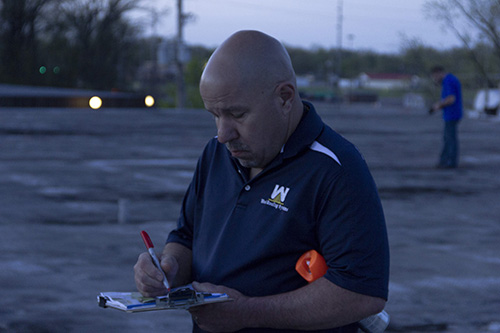
Infrared Moisture Surveys give contractors and inspectors the ability to see what is happening under your roof’s membrane without having to damage your roof system.
Thermal imaging has been used since the 1970s to help determine if your facility needs a total roof replacement or if your facility roof can be repaired in the damaged areas. They are an integral part of delivering the best quality roof at a fair price.
What is an Infrared Roof Survey?
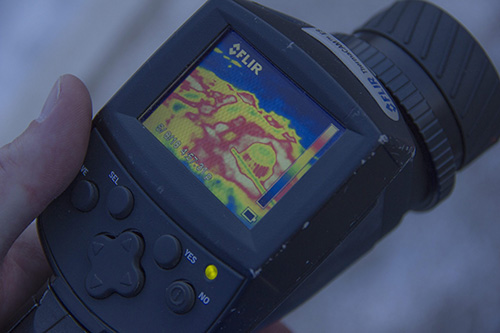
Infrared Moisture Surveys provide an economical way to identify specific areas of wet insulation and moisture present in the existing roof system.
When there’s a leak in the waterproof membrane, water can enter the roof system and saturate the insulation and underlying layers. Wet areas on the roof take longer to cool down with the outside air compared to the dry areas. This means that the wet areas hold heat longer at the end of the day.
Read More: Why is My Commercial Roof Leaking?
A commercial roofing contractor, or roof inspector, will use an infrared camera to take images or videos of the roof surface. Those images help identify what areas of the insulation are saturated without having to tear off the top layer of roof.
How Infrared Surveys Are Performed
Before work is done on a commercial roof, the contractor will visit your facility for a roof survey, and they will schedule an infrared moisture survey. The roof survey will visually inspect the system including the top membrane, flashings, metal edges, wall copings, gutters and any problem areas you have. The infrared survey will be scheduled for an upcoming evening for the team to come back, usually around dusk.
There needs to be precise conditions for an infrared moisture survey to be successful:
- Flat or low-sloped roof
- Clean and dry roof surface
- Mostly sunny and warm during the day
- Little to no wind
- Clear night
During the day, energy from the sun heats up the roof membrane and the insulation underneath. As day turns into evening, the sun sets, and the roof system cools off, the saturated areas of insulation will hold the heat longer than the dry areas.
The contractor will take images of the roof surface using an infrared camera and use those images to identify problem areas on the roof that are unseen from the surface. If you have saturated insulation, your contractor will most likely recommend that they remove any saturated material and replace with new, dry insulation.
Reading a Thermal Image
When an infrared survey is completed, your contractor or inspector will have a series of thermal images to review. It takes a trained professional to use thermal images to diagnose your roof problem and how to fix it.
When looking at a thermal image, the warm spots indicate where saturated areas are holding heat compared to the rest of the roof. These areas are shown in a rainbow spectrum or grayscale spectrum.
On a rainbow spectrum, white is considered to be hottest, then red; yellow tends to be the ambient temperature of the roof surface. Once blue is shown the roof has cooled beyond reading, or the surface has no sign of moisture beneath.
The video below shows how an infrared scanner shows heat vs cool areas.
On a grayscale spectrum, the ambient temperature is shown as black, as you get closer to heat the black will fade into gray and white indicates the hot spots. A core or slit of the roof system should be taken to confirm or when the possibility of skewed results arises.
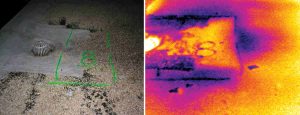
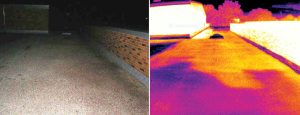
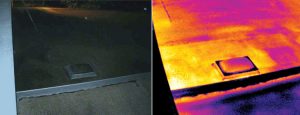
Different types of materials hold water in various patterns:
- Polyiso Boards will have more saturated edges
- Asphalt Roofs will have more circular saturated areas
- Poorly sealed membrane roofing will show saturated along the seams
Advantages of Infrared Surveys
The benefits of utilizing thermal imaging, rather than another survey type, are numerous regarding cost, time and accuracy.
- Detects problems that cannot be visually identified
- Not invasive to your roof system
- Cost-Effective do to advanced technology and short survey time
- Plan a project accurately, saving time and money
- Eliminate unnecessary projects
West Roofing Systems provides free commercial roof surveys for all of our current and potential customers interested in having work done on their facility.
Our sales team and expert technicians perform a comprehensive roof analysis by inspecting conditions, establishing roof assembly through core samples to determine if the project will be on overlay or tear-off, and measuring roof area square footage.
Read More:


